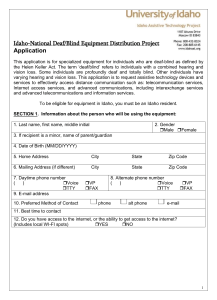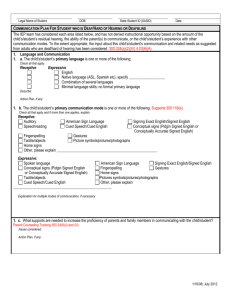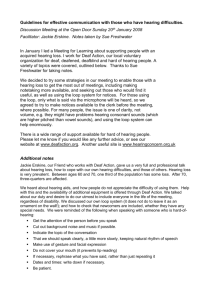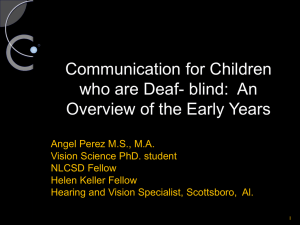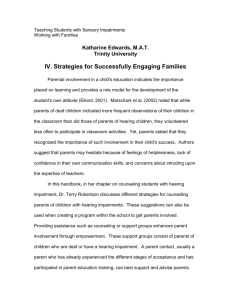Degrees of Hearing Loss
advertisement
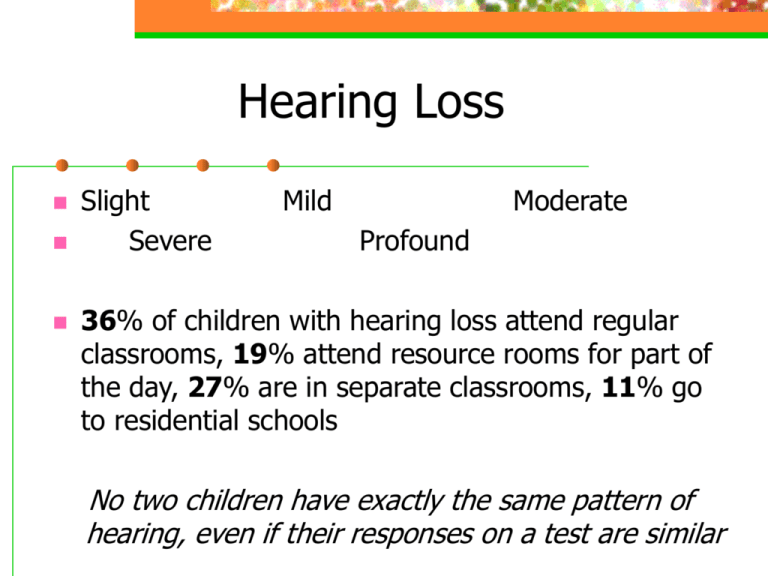
Hearing Loss Slight Severe Mild Moderate Profound 36% of children with hearing loss attend regular classrooms, 19% attend resource rooms for part of the day, 27% are in separate classrooms, 11% go to residential schools No two children have exactly the same pattern of hearing, even if their responses on a test are similar Effects of a Hearing Loss Difficulty learning language Different patterns of social development Many deaf individuals choose membership in the deaf community and culture Educational Approaches Oral/aural: view speech as essential if students who are deaf are to function in the hearing world. Training in producing and understanding speech and language is incorporated into all aspects of education. Cued speech: a method of supplementing oral communication. Total/simultaneous communication: use a variety of forms of communication to teach language to students with hearing loss. Sign language: uses gestures to represent words, ideas, and concepts. Available Technologies Amplification – including FM systems Auditory training Speechreading Educational interpreter Text telephones Closed television captioning Alerting devises Teaching Strategies for Deaf/Hard of Hearing (1) Promote adult-child interaction by pointing out communication patterns and attempts. Promote peer interactions by modeling and practicing play with child. Information learned incidentally by hearing children must be explicitly taught to children who are deaf/hard of hearing. Emphasis on process of learning not just product. Repeat information and present in multiple formats. Teaching Strategies for Deaf/Hard of Hearing (2) Use Experiential Learning Scaffolding Collaborative learning and peer tutoring Visual Aids: Illustrations, semantic maps, graphic organizers, flow charts, videos, slides, television, and computer technology Classroom Design Modifications Listen-Look-Listen sequence of instruction Plan with and for interpreters Blindness/Visual Impairment Visually impaired: 20/70 with correction in the stronger eye. A reduced visual field. Legally blind: 20/200 with correction in best eye. Totally blind with light projection: can identify source of light. Totally blind with light perception: can identify the presence of dark and light. Totally blind: no light perception. Oculomotor problems. Effects of Blindness/ Visual Impairment Limitations in range and variety of experiences Limitations in orientation and mobility and independent travel Limitations in interactions with the environment Delayed language development Slightly different motor development sequence Social isolation and/or delayed development of social skills Difficulty in receiving and expressing affection Stereotypical behaviors – “blindisms” Limited knowledge or misconceptions about human sexuality and reproduction Self-concept of Individuals With Low Vision - Ann Corn View self as whole, not as having “remaining” or residual vision. View environment as stationary and clear. Low vision offers a different aesthetic experience. 20/20 acuity is not needed for most tasks or for O & M within most environments. Clinical measurements do not dictate visual functioning. Visual functioning can be enhanced through the use of optical aide and environmental modifications. The use of low vision is not always the most efficient or preferred method of functioning. Curriculum In addition to the regular curriculum, children who are blind/vi must develop skills in three areas: Skills needed to access the academic curriculum Skills learned incidentally by others Skills specific to students with VI Instructional Methods for B/VI (1) Repeated visual or hand-over-hand kinesthetic demonstrations Systematic instruction Gradual fading of assistance and prompts Significant periods of practice Adapted materials (see slide) Be explicit giving oral presentations Instructional Methods for B/VI (2) Tactual/kinesthetic approach Additional experiences O & M instruction Specific instruction in daily living and social skills Use experiential learning Scaffolding Collaborative learning and peer tutoring Adapted Materials for Children Who Are Blind Tactile aids and manipulatives Enlarge and enhance printed materials Technology aids for reading print Convert print to Braille Computer access & Braille technology aides Oral output devices Descriptive video service Adapted Instruction for Children Who Have Low Vision Approach magnification Lenses Large print Low glare materials “back” lighting Practice listening skills – learning to listen activities; mnemonics O & M training Scaffolding Assess current knowledge. Develop logical sequence of instruction so that each new step builds on what the child already knows. Provide opportunities for the child to practice the information. Collaborative Learning and Peer Tutoring Set up collaborative teams that are heterogeneous so that students with varying ability levels comprise each group Make sure each student has an assignment Develop an assessment that enables each student to succeed at a level of mastery Use peer tutoring activates that allow students to take turns at being a tutor and a mentor Classroom Design Modifications Seat students who speechread closest to speaker. Encourage students to move whenever necessary. Well lighted classrooms without shadows or glare. Always have light on your fact, not behind you. Consider assigning a peer to be a buddy who can signal changes in speakers, help the student follow along, and alert student to alarms. Move potential sources of noise . Carpet as much area as possible. Add pieces of carpeting or bulletin boards to bare walls to absorb sound. References Goetz, L., Guess, D., Stremel-Campbell, K. (1987). Innovative program design for individuals with dual sensory impairments. Baltimore, MD: Brookes. Heward, W. L. (00). Exceptional children: An introduction to special education. Upper Saddle River, NY: Prentice Hall. Holbrooke, M. C. (1996). Children with visual impairments: A parents’ Guide. Bethesda, MD: Woodbine House. Mangold, S. S. (1982). A teachers’ guide to the special educational needs of blind and visually handicapped children. New York, NY: American Foundation for the Blind Turnbull, A., Turnbull, R., Shank, M., a& Leal, D. (1999). Exceptional lives: Special education in today’s schools. Upper Saddle River, NJ: Merrill. Mastropierei, M. A., & Scrugges, T. E. (00). The inclusive classroom: Strategies for effective instruction. Upper Saddle River, NJ: Merrill.

